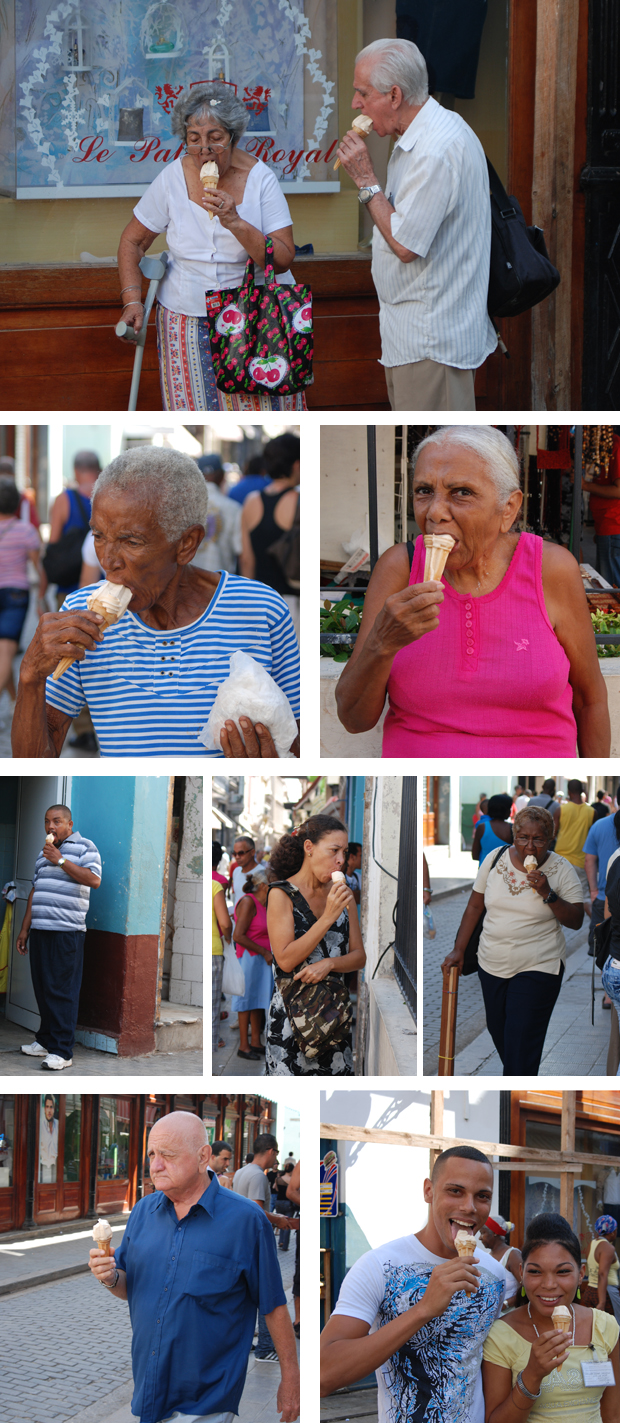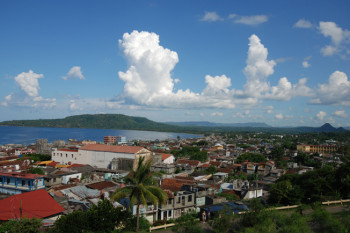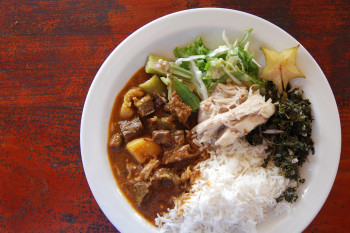Coppelia, HAVANA, Cuba –
Forget cigars, rum and old cars. Forget Hemingway, Fidel and Che. If there are only two things to remember about real Cuban life, it’s this: queues and ice cream.
In this communist nation, shampoo and toothpaste are considered luxuries; ice cream is not. In fact, it’s heavily government subsidized and it costs mere pennies — but it wouldn’t be Cuba without having to line up for it.
Morning, noon, night, Cubans will devour scoops. Ice cream is religion and I’ve repeatedly been told that where locals go to worship is “la cathedral del helado” – the cathedral of ice cream: Coppelia.
So here I am at Coppelia, standing at the hectic intersection of 23rd Avenue and L, confused. I expected a shop; this place looks like a fortress.
A long line endlessly snakes around a large, fenced-in garden complex. I circle around the block, hovering, uncertain where the queue ends or begins.
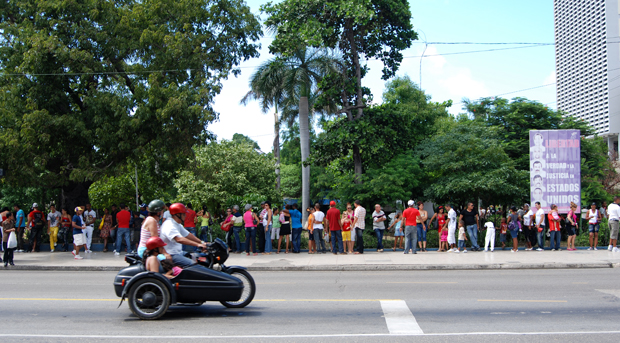
It’s not one line but actually three – no, five. Six? I scratch the back of my sunburnt neck. What’s the difference between them? I pick one and join.
“Como te llamas?” I ask the young man in front of me. He has a pleasant, placid expression on his face. Unsurprisingly, his name is José.
In broken Spanish, I ask what this lineup is for. José replies and he points up to the sky. I don’t understand him. Heaven? God?
We make small talk. He’s 24 and works at a supermarket. I don’t have the heart or the language skills to tell him that his fly is down.
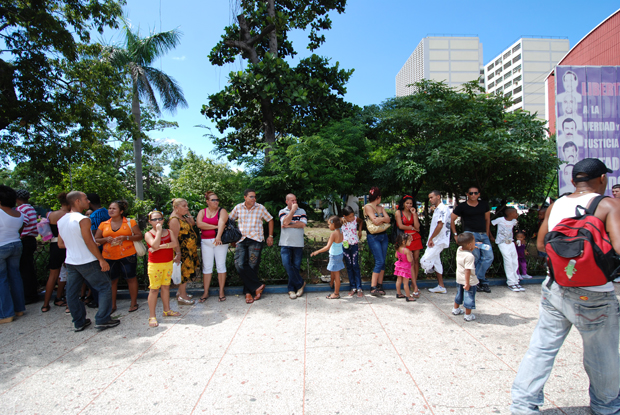
Girls in dangerously short shorts flirt with young bucks. Couples canoodle. University students debate. The line buzzes with chatter. Entire families are here, all generations young through old. Life, vibrant and thriving, is on display and Cubans have mastered the art of the queue. Incredibly, everyone is enjoying themselves, something most Canadians and Americans find impossible to do in a lineup.
Vendors pace the sidewalk selling packets of cookies and other ice cream toppings. Mamas with roly-poly babies attached to their ample hip chat as restless howling youngsters orbit them like electrons.
A security guard approaches and tries to usher me from the line. José explains that tourists don’t have to wait and can go in immediately to another section but will have to pay in convertibles, expensive tourist currency, instead of local peso. Abandon my comrades? Never! I refuse to budge.
An hour passes. The thought of abandoning my comrades crosses my mind. The temperature is sizzling, my skin is scorched. Visions of vanilla cones dance in my head.
Finally! The line moves. We’ve penetrated the fortress, we’ve reached sanctum sanctorum, we’re filing in…into another line.
To my left, an austere looking concrete bar. People perch on high stools while workers in smart red and white uniforms dish out scoops.
To my right, an outdoor patio is packed with groups clustered around metal tables gobbling down fast melting ice cream.
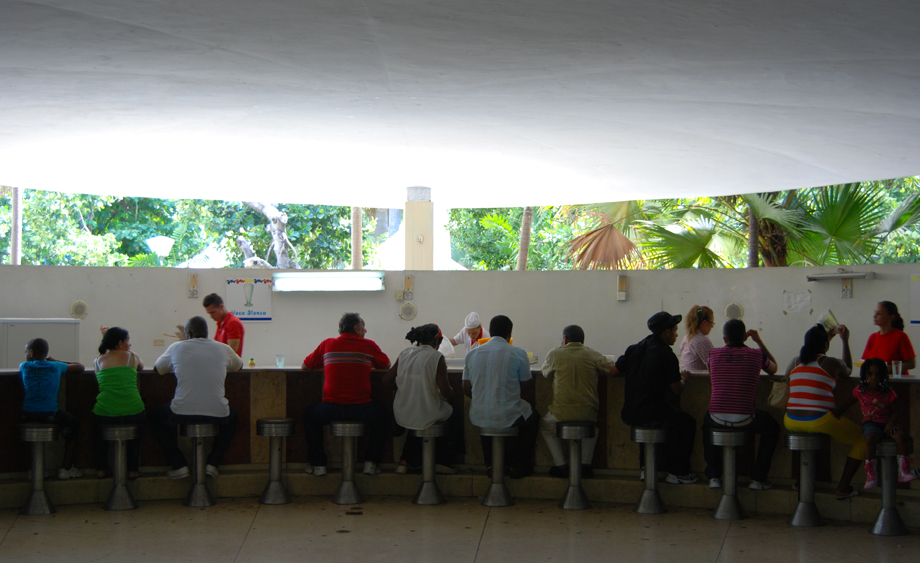
We’re being led in. Now I understand why José pointed to the sky. At the center of the compound, a spiral staircase leads up to a brutalist concrete building shaped like a flying saucer. Ay dios mio, I am going to the mothership.
The second floor is packed. The place reminds me of a high school cafeteria circa 1960: formica tables, metal chairs, lino floors, an ugly relief of geometric designs on the ceiling. José and I share a table with others. A no nonsense waitress comes round.
“Chocolate?” I squeak, shrinking under her stern Soviet-like gaze. She shakes her beehived head: NO. One flavour today: fresa — strawberry. I look around, confused. Everyone is eating pink stuff. I forgot that in Cuba, consumer choice is a luxury. I order two scoops.
…or so I thought I was ordering two scoops. When the waitress returns, I realize my mistake. Ice cream is ordered per “ensalada,” a dish with four heaping scoops. Waste not, want not, I have to eat eight scoops.
The family beside me has five dishes each — 20 scoops — and are having a merry time tackling it. Within two minutes my ice cream has melted into pink soup.
Truthfully, the ice cream isn’t great. It’s sugary and more milky than creamy. It certainly isn’t my preferred full fat, full snob vanilla bean Häagen-Dazs, $6 for a container the size of thimble.
But I’ve just learned what it’s like to pause your life for helado.
And Häagen-Dazs doesn’t come with the social atmosphere, the anticipation. It starts out as people watching – watching the cha-cha-cha, observing how they move and talk, finding the swing and rhythm of Havana that somehow manages to be slow and fast at the same time. Before you know it, you are literally bumping shoulders and hips with Cuban life that’s unapologetically in your face. Sweat it out and you’re rewarded at the end with a sweet, cold treat – and kindness.
I am about to give pesos to the waitress when I learn that José has already paid for mine. He refuses to accept my money. I’m floored by this gesture. Each bowl is a piddly 5 cents – significant considering that the standard monthly wage in Cuba is only a few dollars.

Just the facts: Coppelia Ice Cream
Coppelia is one of the largest ice cream parlours in the world. It was popularized by Tomás Gutiérez Alea’s film Fresa y chocolate (Strawberry and Chocolate), as it was the setting of a pivotal scene in the movie. Coppelia is located at the corner of Calle 23 & L, across from Yara Cinema, Vedado district, Havana. 11 am – 11pm
Havana has a convenient and cheap hop on/hop off tourist bus that gives you a great tour of the city. A one-day unlimited pass is 5 CUC per person. T1 route stops at the famous Hotel Habana Libre, just one block from Coppelia.
Cubans and ice cream
I stood in near a penny ice cream shop in old Havana for 10-minutes snapping photos of that first lick, bite and gobble. Here is the result:
